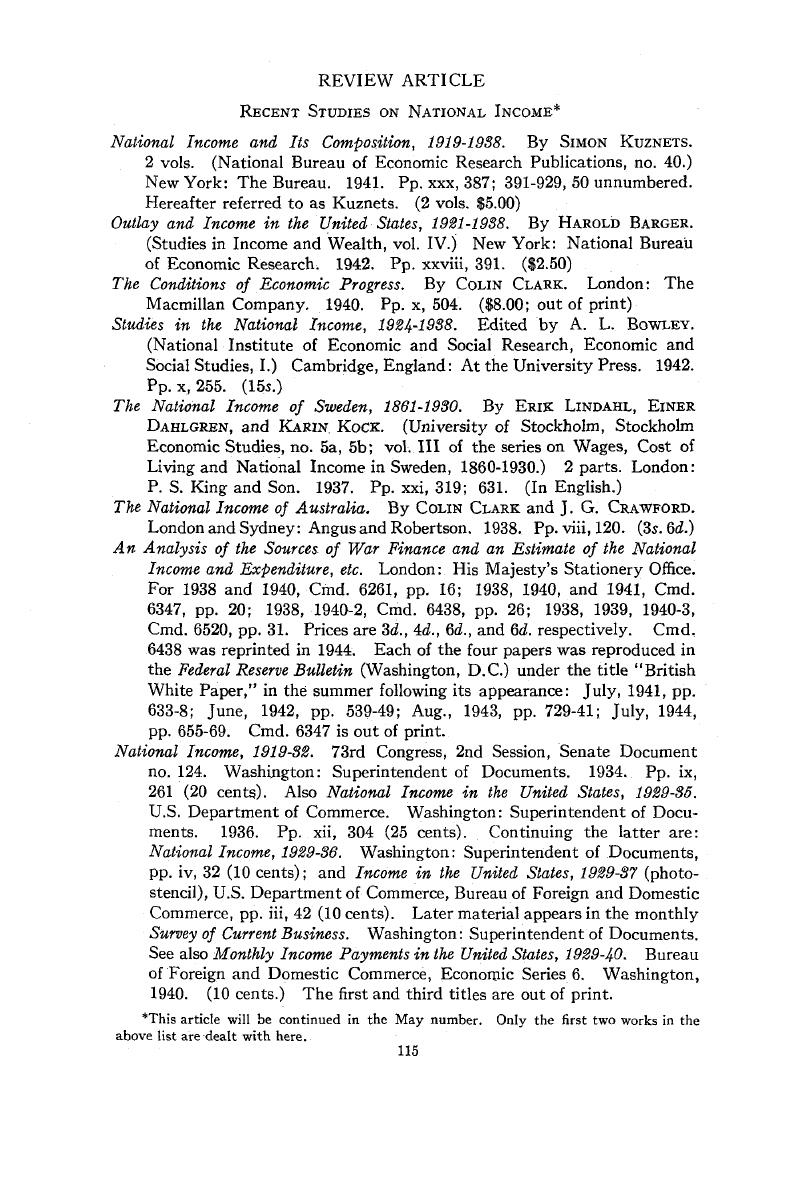Article contents
Recent Studies on National Income*
Published online by Cambridge University Press: 07 November 2014
Abstract

- Type
- Review Article
- Information
- Canadian Journal of Economics and Political Science/Revue canadienne de economiques et science politique , Volume 11 , Issue 1 , February 1945 , pp. 115 - 129
- Copyright
- Copyright © Canadian Political Science Association 1945
Footnotes
This article will be continued in the May number. Only the first two works in the above list are dealt with here.
References
1 As indicated by the preface, the title page, and a published extract from the National Bureau's minutes, the work comprises at the literary level, and at the level of policy, the labours and judgments of a number of individuals and editorial authorities, but for convenience we will refer to it as the work of Professor Kuznets, and hope that no injustice is done.
2 King, W. I., The National Income and Its Purchasing Power (New York, National Bureau of Economic Research, 1930).Google Scholar
3 Kuznets, Simon, National Income and Capital Formation, 1919-1935: A Preliminary Report (New York, National Bureau of Economic Research, 1937).Google Scholar
4 Summarized in Bowley, , Studies in the National Income, p. 8.Google Scholar
5 It should be added that considerable pains have been taken in estimates for a number of branches such as professional service, but it is doubtful whether it is worth while to prepare such material for minor components unless it is reliable enough to be used as a basis for industrial monographs.
6 See, however, Mr. Barger's doubts in his Outlay and Income in the United States, 1921-1938, reviewed below.
7 Kuznets, Table 100, p. 524.
8 Ibid., p. 535.
9 Within the field of quantitative description, a mature system of income statistics has the important virtue of making data on prices and volume equally accessible. Hitherto, the evidence was confined here to records of prices and there to those of volume, warping the resulting interpretations now toward the pecuniary aspects and then toward the purely physical, each of which was supported by one or more schools of writers. This need no longer occur, thanks to the grooming of statistical systems by income statisticians. At the same time the importance of household production for use in the home has been more thoroughly examined, with the result that its significance for real income now appears greater than before the alleged pecuniary bias of income studies drew attention to it.
10 Measurement of Social Phenomena (London, 1915), p. 20.Google Scholar
11 Twenty-Fourth Annual Report of the National Bureau of Economic Research (New York, 1944), pp. 10–11.Google Scholar
12 The phrase approximation by parts is new, at any rate in economic statistics, and is a genuine contribution to the terminology.
13 Devices relying on offsetting errors, of which the method of approximating by parts is one, may be pushed too far. Suppose, for example, that one hundred persons could be found each of whom was willing to guess the position of a vessel sailing on the usual course from New York to Gibraltar, in terms of its distance from New York, without having any information whatever on its position. The guesses made by these persons would probably fall into a roughly symmetrical frequency distribution with a concentration around half the distance between the two ports. Such a result might lead some persons to conclude that the distance had been determined by scientific observation.
14 In other literature this limitation has been frankly recognized. See the British White Papers entitled Sources of War Finance and an Estimate of the National Income and Expenditure reviewed below; also MacGregor, D. C., “Gross and Net Investment in Canada—Tentative Estimates” (Canadian Journal of Economics and Political Science, 02, 1941, p. 46).Google Scholar
15 Barger, . Outlay and Income in the United States, p. 39 Google Scholar, also, in another connection, at p. 101.
16 It seems that positive business savings may have expansive, neutral, or contractive effects upon aggregate spending and that they are not necessarily associated with additions to fixed or circulating capital. The economic result depends largely upon how a firm's surplus has been disposed of, but this cannot be discovered with accuracy from a mere comparison of balance sheets.
17 E.g., income from work on roads, and in canning factories, fishing, household industries, investments, insurance, and government. Compare the papers by Messrs. Hope, Burton, and Skeoch in this Journal, Aug., 1943, and May, 1944.
18 Progress of the United States in Population and Wealth in Fifty Years (New York, 1843), p. x, 211.Google Scholar
19 To some extent, too, general purpose estimates have been thrown up semi-automatically by the growing accumulation of industrial censuses, without much thought of problems or objectives other than the desire to pull together scattered material.
20 Cf. Barger, , Outlay and Income in the United States, pp. 79–80.Google Scholar
21 Cf. the difficulties encountered by this reviewer in estimating consumers' expenditure in Alberta (in this Journal, Nov., 1936, pp. 540-2).
22 The Canadian indexes of retail sales published by the Dominion Bureau of Statistics since 1930 are an example of a ballon d'essai which succeeded, while the indexes of volume of production, and estimates of expenditures of foreign tourists in Canada (prior to their revision a few years ago), are examples of similar attempts which failed.
- 1
- Cited by


